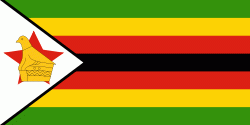Kariba District (Kariba District)
Kariba is a district and constituency on the shores of Lake Kariba in the Mashonaland West Province of northern Zimbabwe, along the border with Zambia. The constituency comprises 12 rural wards or municipalities in Kariba Rural, also known as Nyaminyami Rural District, and 9 urban wards in Kariba Town, the district capital. The district's total population was just under 60,000 in 2011. Kariba town was built to house the workers who built Kariba Dam, which was completed in 1960 to supply Zimbabwe and Zambia with hydroelectric power, and which gave rise to one of the largest artificial lakes in the world. The creation of the Kariba Lake led to a thriving fishing industry, but following Zimbabwe's economic collapse, Kariba became the least developed district in the country. Kariba is also the most isolated district in Zimbabwe, with no tarred roads as of 2002. The main economic activities are subsistence agriculture, fishing and subsistence hunting. The district, which includes Matusadona National Park, suffers from high levels of wildlife poaching and high levels of human-wildlife conflict.
Map - Kariba District (Kariba District)
Map
Country - Zimbabwe
 |
 |
| Flag of Zimbabwe | |
The British South Africa Company of Cecil Rhodes demarcated the Rhodesia region in 1890 when they conquered Mashonaland and later in 1893 Matabeleland after a fierce resistance by Matabele people known as the First Matabele War. Company rule ended in 1923 with the establishment of Southern Rhodesia as a self-governing British colony. In 1965, the white minority government unilaterally declared independence as Rhodesia. The state endured international isolation and a 15-year guerrilla war with black nationalist forces; this culminated in a peace agreement that established universal enfranchisement and de jure sovereignty as Zimbabwe in April 1980. Zimbabwe then joined the Commonwealth of Nations, from which it was suspended in 2002 for breaches of international law by its government under Robert Mugabe and from which it withdrew in December 2003.
Currency / Language
| ISO | Currency | Symbol | Significant figures |
|---|---|---|---|
| ZWL | Zimbabwean dollar | 2 |
| ISO | Language |
|---|---|
| SN | Shona language |















